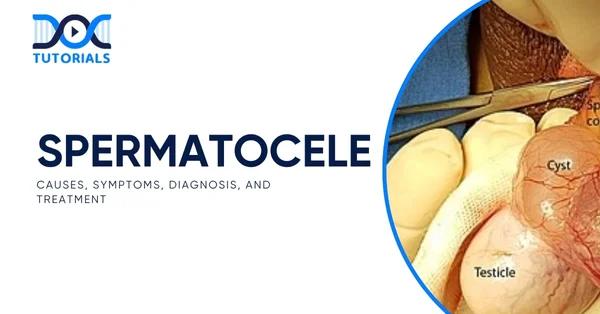Spermatocele: Causes, Symptoms, Diagnosis, and Treatment

Spermatocele is a health condition characterised by the formation of fluid-filled cysts around the testicles, most commonly located on the epididymis, a tube that stores sperm. These are mostly painless cysts, which are usually asymptomatic and are also commonly called spermatic cysts.
Although generally harmless, they can sometimes mimic other testicular conditions, making accurate diagnosis essential for effective clinical evaluation. It is essential for the NEET PG aspirants to learn the causes, symptoms, diagnosis, and management of spermatocele to make informed decisions during clinical practice.
This comprehensive guide will give you a clear idea of this condition for exam preparation. Keep reading for a detailed insight.
What is a Spermatocele?
A spermatocele is a fluid-filled cyst that is formed in the epididymis, which is the coiled tube located behind and above each testicle. The epididymis plays an important role in storing and transporting sperm. Spermatoceles are filled with a clear fluid or an opaque fluid, which may contain sperm as well.
It is also referred to as a spermatic cyst, or epididymal cyst. Spermatoceles do not cause pain, and thus, one may not feel the lump at the beginning. However, even having a lump around the testicle might be alarming even when it does not hurt.
What are the Different Types of Spermatocele?
There are mainly 2 types of spermatocele, which are as follows:
- Simple Spermatoceles
These unilocular (single-chambered) cysts are normally filled with clear fluid, which may also contain sperm. They are relatively small and do not usually generate any significant pain.
- Complex Spermatoceles
These cysts are more complex and usually have more than one chamber (multilocular) filled with denser, protein fluid and spermatozoa. They are more likely to increase in size and lead to symptoms compared to simple spermatoceles.
What are the Causes of Spermatocele?
Several factors may lead to the formation of a spermatocele:
- Blockages in the Epididymal Ducts
When the tiny tubes that store and carry sperm become blocked, fluid can build up and form a cyst.
- Injury or Trauma
An accident or an impact on the testicles or scrotum may disturb the epididymis, leading to the development of a spermatocele.
- Infections
The infection around the epididymis leads to inflammation that could interrupt the flow of sperm and develop a cyst.
- Congenital Abnormalities
Certain people are born with a defect in their tubes to get rid of sperm, and therefore, this makes them prone to spermatoceles.
- Surgical History
Surgical procedures around the scrotum, like a vasectomy, may change the anatomy and raise the possibility of a spermatocele.
- Hormonal Imbalances
Less commonly, the epididymal ducts can be affected by changes in the levels of some of the hormones, which in turn lead to the development of cysts.
- Idiopathic Cases
In many instances, no clear cause is found. These cases are labelled idiopathic.
- Other Contributing Factors
Activities such as sitting for long periods or engaging in strenuous physical work may place pressure on the epididymis, potentially leading to inflammation and cyst development.
What are the Risk Factors of Spermatocele?
The following are the risk factors of spermatocele:
- Gender
Since spermatoceles are linked to the male reproductive system, they only develop in males.
- Age
Spermatoceles are most commonly diagnosed in men aged 40-60, although spermatoceles may manifest themselves at any age.
- Existing Health Conditions
Male individuals who have already experienced epididymitis or other conditions which impact the testicles are at an increased risk of getting a spermatocele
What are the Symptoms of Spermatocele?
A spermatocele does not induce any noticeable symptoms in the majority of cases. Nevertheless, there is a chance that some people could observe the following spermatocele symptoms:
- Painless swelling or lump in the scrotum
- A feeling of pressure or weight over the involved testicle
- The increasing development of the cyst over time
- Redness or inflammation in the scrotum
- Fever or chills, which may indicate an underlying infection
How to Diagnose Spermatocele?
In order to assess a spermatocele in the testicle and eliminate other potential causes, a physician might perform a number of tests in order to assess the problem:
- Transillumination
It includes illumination of the light upon the lump. Spermatoceles typically appear translucent, in contrast to solid masses, which do not allow light to pass through.
- Ultrasound
It is a non-invasive imaging method with the help of which it is possible to obtain detailed images of the structure of the testicles, thus determining the presence and nature of a cyst.
- Laboratory Tests
If there is associated testicular pain, tests such as a urinalysis or screening for sexually transmitted infections may be advised. These help identify any underlying infection or inflammation that could be contributing to symptoms.
What are the Treatment Options for Spermatocele?
Various kinds of spermatocele treatments can be used to treat spermatocele, especially where it produces perceptible symptoms or discomfort due to the cyst. These spermatocele treatments are as follows:
- Pain Relief
Minor pain may be controlled using over-the-counter pain reliever drugs like paracetamol or ibuprofen.
- Aspiration
In this process, a thin needle is inserted into the cyst to extract the fluid content, thus resulting in short-term relief of the pressure or swelling.
- Sclerotherapy
After the cyst is drained, sclerosing fluid is put in the cyst to ensure less recurrence. While this method can be effective, it carries a risk of damaging nearby tissues, including those involved in sperm transport.
- Surgical Removal
When the spermatocele becomes large or continues to cause symptoms, surgical removal through a minor scrotal incision may be recommended. This option is typically considered when less invasive measures prove ineffective.
FAQs About Spermatocele
- What is a spermatocele?
A spermatocele is a fluid-filled cyst that develops in the epididymis, the coiled tube situated behind and above each testicle. It has either clear or cloudy fluid and usually contains sperm.
- What leads to the formation of a spermatocele?
The precise cause of spermatocele remains uncertain. However, it is assumed that it could be caused by blockages inside the epididymis. The causes of such blockages may have been some earlier inflammation or trauma to the region.
- Is it possible for a spermatocele to resolve without intervention?
Smaller spermatoceles may occasionally shrink or resolve naturally without medical treatment. However, larger cysts tend to persist and may gradually increase in size over time. A medical professional should assess any noticeable lump or swelling in the testicles to rule out other potential conditions.
- What lifestyle adjustments can help manage spermatocele?
Adopting certain lifestyle habits can help ease discomfort linked to spermatocele. Wearing well-fitted, supportive underwear may provide relief while following a healthy lifestyle, such as staying active and maintaining a balanced diet, which can support overall reproductive health and comfort.
- Is infertility linked to spermatoceles?
Spermatoceles themselves do not lead to male infertility. However, surgical removal of a spermatocele may occasionally result in a blockage of the epididymis, which has the potential to impact fertility.
Conclusion
Spermatocele is a benign condition affecting the male reproductive system, often presenting as a painless scrotal lump. While usually harmless, recognising its clinical presentation, understanding its underlying causes, and being familiar with diagnostic and treatment options are essential for proper management and patient reassurance.
As a NEET PG aspirant, a thorough understanding of spermatocele is crucial for accurate diagnosis and decision-making in clinical settings. DocTutorials gives you comprehensive learning resources and expert guidance to support your exam preparation and clinical knowledge.
Explore our NEET PG course to strengthen your medical knowledge and achieve your academic goals!
Latest Blogs
-

INI CET Exam 2025: Your Roadmap to Success – Key Topics, Strategies, and Lessons from Last Year’s Papers
The INI CET exam is more than just a test; it’s a significant milestone for many medical students aiming to…
-

INI CET Exam Success: Previous Year Question Papers & Ultimate Guide – INI CET PYQ
One can feel overwhelmed while preparing for the INI CET (Institute of National Importance Combined Entrance Test). A vast syllabus,…
-

INI CET Exam Pattern 2024: A Complete Guide with Subject-Wise Weightage
The Institute of National Importance Combined Entrance Test (INI CET) is your key to entering some of the most prestigious…




